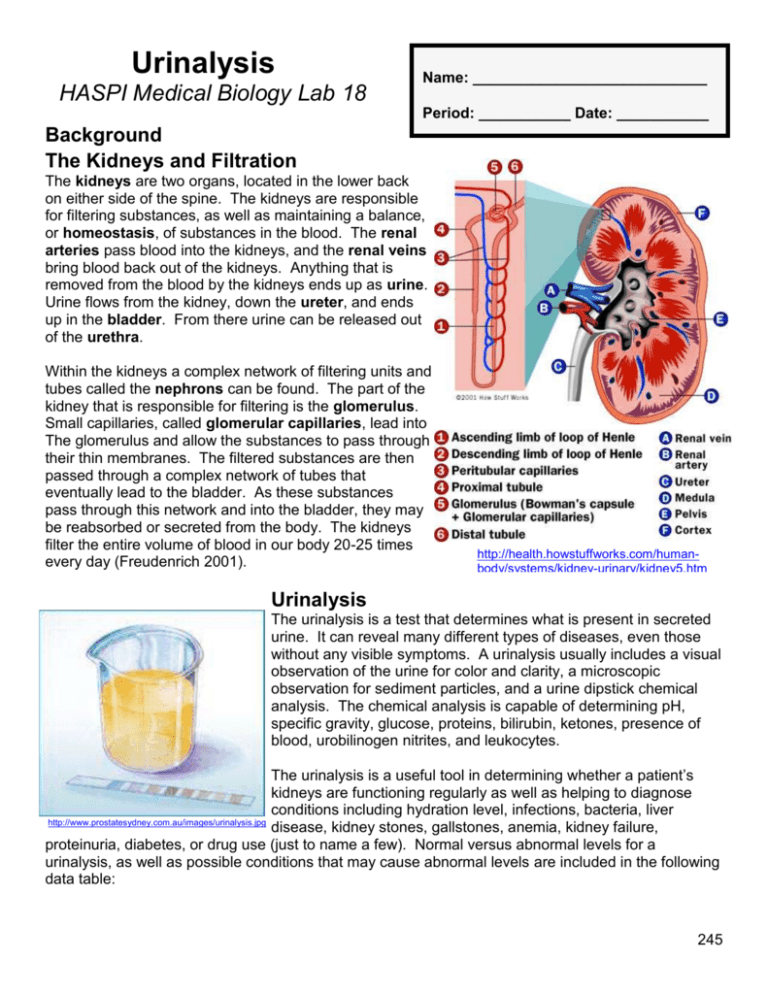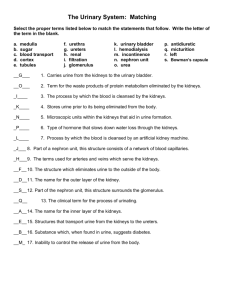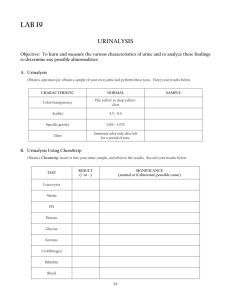Simulated Diabetes Test
advertisement

Urinalysis HASPI Medical Biology Lab 18 Name: ____________________________ Period: ___________ Date: ___________ Background The Kidneys and Filtration The kidneys are two organs, located in the lower back on either side of the spine. The kidneys are responsible for filtering substances, as well as maintaining a balance, or homeostasis, of substances in the blood. The renal arteries pass blood into the kidneys, and the renal veins bring blood back out of the kidneys. Anything that is removed from the blood by the kidneys ends up as urine. Urine flows from the kidney, down the ureter, and ends up in the bladder. From there urine can be released out of the urethra. Within the kidneys a complex network of filtering units and tubes called the nephrons can be found. The part of the kidney that is responsible for filtering is the glomerulus. Small capillaries, called glomerular capillaries, lead into The glomerulus and allow the substances to pass through their thin membranes. The filtered substances are then passed through a complex network of tubes that eventually lead to the bladder. As these substances pass through this network and into the bladder, they may be reabsorbed or secreted from the body. The kidneys filter the entire volume of blood in our body 20-25 times every day (Freudenrich 2001). http://health.howstuffworks.com/humanbody/systems/kidney-urinary/kidney5.htm Urinalysis The urinalysis is a test that determines what is present in secreted urine. It can reveal many different types of diseases, even those without any visible symptoms. A urinalysis usually includes a visual observation of the urine for color and clarity, a microscopic observation for sediment particles, and a urine dipstick chemical analysis. The chemical analysis is capable of determining pH, specific gravity, glucose, proteins, bilirubin, ketones, presence of blood, urobilinogen nitrites, and leukocytes. The urinalysis is a useful tool in determining whether a patient’s kidneys are functioning regularly as well as helping to diagnose conditions including hydration level, infections, bacteria, liver http://www.prostatesydney.com.au/images/urinalysis.jpg disease, kidney stones, gallstones, anemia, kidney failure, proteinuria, diabetes, or drug use (just to name a few). Normal versus abnormal levels for a urinalysis, as well as possible conditions that may cause abnormal levels are included in the following data table: 245 Name:____________________________________________ Date: ___________ Period: ________ Abnormal Vs. Normal Urine Appearance Yellow and Clear Dark Yellow Brownish or Green Visual Observations Reddish-Amber Cloudy Microscopic Observations Milky Appearance Crystals Red Blood Cells (erythrocytes) White Blood Cells (leukocytes) Large Particles (casts) Property Chemical Analysis Specific Gravity pH Glucose Protein Bilirubin Ketones Urobilinogen Nitrite Possible Conditions Normal May indicate concentrated urine from dehydration May indicate bile pigments May indicate urobilinogen, which is produced in the intestine by bacteria in bile; may indicate evidence of liver disease, Addison’s, or other conditions May be evidence of phosphates, white blood cells (WBCs), bacteria, epithelial cells or fat May indicate presence of WBCs, bacteria or fat Possible Conditions Can be normally occurring; persistent crystals may indicate kidney stones or infection May indicate irritation of the urinary tract organs by calculi or physical trauma; may also indicate hemolysis of red blood cells due to such conditions as anemia, transfusion reactions, burns, or renal disease Indicates inflammation of the urinary tract usually caused by bacterial infection May indicate chronic kidney failure, proteinuria, or be present after strenuous exercise Possible Conditions Normal urine specific gravity is between 1.015 and 1.025 Less than 1.015: may indicate excess fluid intake, diabetes insipidis or chronic renal failure More than 1.025: may indicate limited fluid intake, dehydration, fever, kidney inflammation Normal urine pH is between 6-7; below 6 may indicate gout, fever, or kidney stones; above 7 may indicate urinary tract infection, vegetarian diet, bowel obstruction, vomiting, or drug use Normal urine has no glucose. Presence may result from excessive carbohydrate intake or diabetes mellitus Normal urine has no protein. Presence may indicate abnormally increased permeability of the glomerular membrane, kidney trauma, ingestion of heavy metals, bacterial toxins, glomerulonephritis or hypertension; glomerular damage or inflammation; may also arise under conditions of physical stress or strenuous exercise Normal urine has no bilirubin. Presence may indicate liver pathology such as hepatitis or cirrhosis Normal urine has no ketones. Presence may indicate starvation or abnormal metabolic processes such as excessive metabolism of fats or proteins in the body; possibly indicates starvation or diabetic ketosis Normal urine has very little to no urobilinogen nitrite. Presence may indicate bacterial contamination / urinary tract infection (UTI) Freudenrich, C. 2001. How Your Kidneys Work. Discovery Fit & Health. http://health.howstuffworks.com/human-body/systems/kidney-urinary/kidney.htm 246 Name:____________________________________________ Date: ___________ Period: ________ Materials 5 ml Urine sample A 5 ml Urine sample B 5 ml Urine sample C 5 ml Urine sample D 5 ml Urine sample E 5 Test tubes Test tube holder Graduated cylinder Slide Cover slip 5 Urine test strips Test strip indicator 5 Plastic pipettes Microscope Paper towels Procedure Purpose: The goal of this lab will be to perform a urinalysis on urine samples for 5 patients. Some background information for each patient is given below. Patient A: A 25-year-old male complains of feeling he “needs to go” all the time, but typically only produces a small volume of urine. The patient experiences a mild degree of discomfort during urination. He is also experiencing pain in his lower back. Patient B: A 28-year-old overweight male is experiencing excessive thirst (polydipsia), frequent urination (polyuria), increased appetite (polyphagia), and fatigue. He is also experiencing unexplained weight loss. Patient C: An 18-year-old healthy female provided a urine sample for a routine physical examination. She had difficulty producing even a small volume of urine. The physician noted that she had only a 12-ounce diet soda and some carrots to eat all day. Patient D: A 17-year-old female complains of joint pain and an unusual rash. She does not eat any red meat or poultry, and her only form of protein is fish – primarily tuna – which she eats daily. Patient E: An elderly female patient presents with abdominal pain following meals. The condition is more severe following a greasy meal. 1. Label each of your test tubes A, B, C, D, and E. Place them in the test tube holder. 2. Place 5 ml of each urine sample in the appropriately labeled test tube – USE A DIFFERENT DROPPER FOR EACH SAMPLE. 3. Observe each urine sample for color and clarity. Refer to the Background Section for reference. Record your observations in Data Table 1. 4. Place a drop of urine sample A onto the slide and place the cover slip over it. View urine sample A under the microscope to identify any sediment particles within the urine. If you see ANY sediment or crystals in the urine record a + in Data Table 1. If there are no visible particles record a – in Data Table 1. 5. Clean off the slide and cover slip. Repeat step 4 for the remaining four urine samples. 6. Place one of the urine test strips on a paper towel. Use the plastic dropper for the urine sample for Patient A to place urine on each of the 10 boxes on the strip. Each box requires 30120 seconds and the time needed is for each test is on the urine test strip indicator sheet. Use 247 Name:____________________________________________ Date: ___________ Period: ________ the test strip indicator sheet to compare your urine test strip. Record the value from the indicator sheet for each test in Data Table 1. 7. Repeat step 6 for the remaining four urine samples. Analysis Data Table 1 Color Normal Urine Yellow Clarity Clear Sediment Particles Specific Gravity pH None 1.0151.025 6-7 Ketone None Glucose None Bilirubin None Red Blood Cells Protein None Urobilinogen Nitrite Leukocytes None Patient A Patient B Patient C Patient D Patient E None None 248 Name:____________________________________________ Date: ___________ Period: ________ Analysis Questions - on a separate sheet of paper complete the following Review - on a separate sheet ofany paper complete the following 1. CreateQuestions a table that summarizes each patient, abnormal results detected in their urine 1. sample, What isand the what responsibility the kidneys? possible of conditions may have caused each abnormal result. 2. How do the kidneys maintain homeostasis 2. Why is it important to develop a case historyinofthe thebody? physical symptoms of each patient to be 3. used Howalong does with bloodthe getphysical into andtests out of the kidneys? performed on the patient’s urine specimen? Howreceive does urine leavesamples the kidneys to from be secreted out in of the the morning, body? and one from the 3.4. You two urine – one the patient 5. afternoon. What is theWould filtering of thethe kidney called? youunit expect urinalyses to have the same results? Why or why not? How much blood do the kidneys 4.6. The presence of blood in the urinefilter can daily? indicate a serious kidney problem. Why are kidney 7. problems List 5 conditions that can be detected by a urinalysis? so serious? Can the adiet affect the urine? How? 5.8. Suppose urine sample revealed abnormal results, such as protein in the urine. If there is 9. aDefine the following urinary conditions: albuminuria, renal calculi, ketonuria, result differing from the norm, should a glycosuria, physician always make an immediate diagnosis of pyuria, glomerulonephritis.\ a hematuria, disorder? Why or pyelonephritis, why not? Identify and label the filtering 1-6be and the parts of a the kidney A-F in Figure A the below. 6.10.How would the specific gravity units of urine different after vigorous workout without consumption of significant quantities of water? 7. The presence of ketones is often high in the urine of people with diabetes, and people who suffer from anorexia. What characteristics do these two groups have in common? 8. What factors would contribute to a very high or very low pH in urine? 9. CONCLUSION: In 1-2 paragraphs summarize the procedure and results of this lab. 10. Figure A 249 Name:____________________________________________ Date: ___________ Period: ________ 250







